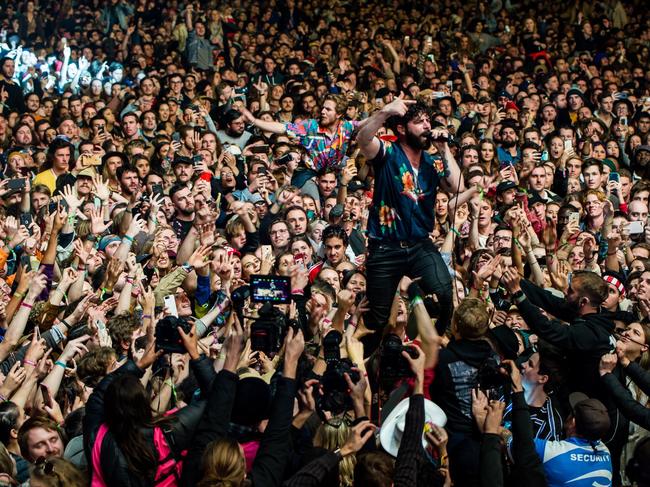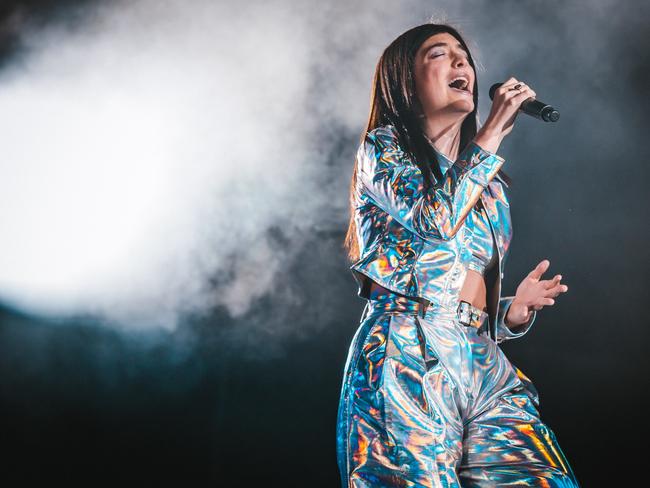Hey, Mr DJ, when will big concerts finally return?
As the fate of festivals hangs in the balance, live music is taking baby steps toward a comeback — minus the mosh pit.

The last weekend of July is normally marked by a sea of boiler suits, leopard print and glitter descending on the North Byron Parklands for Splendour in The Grass. The winter festival’s 20th anniversary has now been postponed until mid-2021, after it was originally pushed back to October in response to coronavirus restrictions. The co-founders of the event, which has drawn as many as 42,000 music lovers to the event, say they are trying to rebook the original 2020 headliners including Flume, The Strokes and Tyler the Creator.
Regional touring event Groovin The Moo and Download Festival have also scrapped their 2020 editions, signalling a festival freeze for the months to come, with only Falls Festival – set to feature an all-Australian line-up – holding on for dear life with three events set to be held across New Year’s Eve in three states.
Behind the scenes, Australia’s music industry leaders are understood to be pushing the federal government for travel exemptions similar to those that apply to foreign students to allow for international artists to visit despite the nation’s closed borders. However, with outdoor entertainment venues unable to operate at more than 25 per cent capacity and the absence of any clear timeline for the reopening of borders, an industry that relies heavily on global artists and packing in the crowds is scrambling to reimagine its future.

In late June, small venues in some capital cities began to program live events again, with great care being paid to enforce social distancing norms that were all but unthinkable during the peak of the annual summer festival season, where the likes of Cold Chisel played to 210,000 fans nationwide in a series of outdoor shows.
In NSW, the government has earmarked November as the month wherein 1000 COVID-safe gigs will take place across the state, with Jimmy Barnes, Tones and I, Paul Kelly and Missy Higgins down to perform at locations yet to be announced as part of a series dubbed Great Southern Nights. Sydney pub The Lansdowne Hotel has reopened its 250-capacity band room to a maximum of 50 attendees seated at candle-lit tables, while Brisbane mainstay The Zoo will in July begin a series of shows – playfully named “anti-social” – capped at 100 tickets and following strict set times so that ticket holders aren’t sharing the same space indoors for too long.
With great care – and smaller venue capacities – comes the necessity of greater ticket prices.
The Zoo, for instance, has opted to implement a $40 minimum venue spend on top of the ticket price to ensure some measure of financial viability for the 450-capacity live room to open its doors. In effect, this means that entrance to a gig headlined by Brisbane indie rock veterans Screamfeeder on July 23 will cost about $60, with the $40 in venue credit able to be used on drinks and merchandise.
This shrunken stop-gap concert format won’t suit all artists or musical styles, of course: it is difficult to imagine dance music fans or heavy metal head-bangers politely staying in their seats for the duration of a set featuring their favourite high-energy songs.
Yet while the sweaty intimacy of a live mosh pit or strobe-lit dance floor feels like a distant dream in the age of coronavirus, music executives say bigger shows can start up again when a vaccine or testing, tracing and treatment procedures are in place to make concert goers feel that big crowds are safe. Even when large concerts return, they are likely to be different to what came before: temperature checks, contactless ordering and hand-sanitiser stations could be the new norm.
In the long term, packed arenas and stadium shows with reduced crowds aren’t possible without concert promoters suffering significant losses. That’s because the cost of staging an arena concert is so high – and the profit margins usually so tight – that promoters depend heavily on ticket sales and concessions like beer, food and parking to simply break even. And neither fans nor artists are particularly fond of half-full concerts.
In recent weeks, the national cabinet has announced that stadiums will be able to hold up to 10,000 spectators from July as part of step three in Australia’s reopening timeline. All venues will be required to be ticketed and seated, with social distancing rules enforced. While no music events are scheduled in the near-term, crowd behaviour and ticket uptake at stadium sporting events will be watched closely by concert promoters.
As well, Western Australia has recently embraced the return of live music, as the state moved to its fourth phase of easing COVID restrictions. In WA, the two-square metre rule will still be in place, but concert halls, live music venues and pubs will be able to host unseated performances. Large sports and entertainment stadiums can host punters at 50 per cent capacity, but large scale events like music festivals remain off the cards.
Some of Australia’s largest performing arts and sports organisations announced the formation of an industry group to carve out a road map for mass gatherings. For the first time, the sports and arts industries are united to fight a common enemy under COVID-19. Under the name Live Entertainment Industry Forum, the group aims to work in conjunction to support the resumption of large events for fans. LEIF includes music executives from three of the nation’s biggest promoters in Frontier Touring, Live Nation and TEG.
Live Nation chief executive Roger Field says the music industry is working to have medium-sized shows back on stage in the next three months.
“I’d like to think that we’d get back to crowds of a couple of thousand in theatres or the like in mid-September, and I’d like to think we may see New Year’s Eve events happen,” he tells The Australian.
Mr Field says it’s vital to distinguish between live concerts as “organised gatherings” versus “mass gatherings” when planning for a COVID-safe return of concerts. “We have information on the patrons, we have the ability to communicate with them pre-, during and post-event to encourage and enforce certain behaviours in the environment and we have them contained for a period of time,” he says.
“So there’s a lot we can offer around a New Year’s Eve time period that is more controlled and manageable than there being no [organised] events.”
The chief executive of fellow concert promoter TEG, Geoff Jones, foresees the biggest hindrance to the health of the live music industry attached to the length of time that international artists are barred from entering the country.
“We depend on how well other countries are going, but there is more optimism appearing every day,” he says. “For the short- term until the end of the year, it will all be about domestic artists, and hopefully by early next year it can be back to international artists.”
“We’ve got a lot of great domestic artists of all different genres of music and I think they already shine,” says Jones. “There’s an appetite out there: we’ve seen the demand in New Zealand, for example.”

The federal government, which held a round table with the industry late last month, recognised the toll the crisis has taken on the industry last week when it announced a $250 million package of grants and loans to the arts.
Alongside funding for theatre, film and television, part of the package includes $75m in grants for new festivals, concerts, tours and events that will be able to take place “as social distancing restrictions ease”.
For those not tantalised by the offer of seated shows offered by the likes of Lansdowne Hotel and The Zoo, there’s the novelty of watching your favourite band play while you sit behind the wheel. It’s a concept that has spread across the world, with the biggest series to date set to take place at Melbourne’s Flemington Racecourse from July 10, when popular acts including Ball Park Music, Alex Lahey and Lime Cordiale will perform on a raised festival stage before parking grids designed for optimal sight lines.
The domestic music industry will be watching these first steps with great interest. After a painful few months of silent and empty music venues, the lighting and sound systems are being switched on, sound-check is underway, and it’s not long now before show time.
